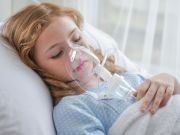- Navigating Your Midlife Crisis: Embracing New Possibilities
- City Raccoons Showing Signs of Domestication
- Mapping the Exposome: Science Broadens Focus to Environmental Disease Triggers
- One Week Less on Social Media Linked to Better Mental Health
- Your Brain Changes in Stages as You Age, Study Finds
- Some Suicide Victims Show No Typical Warning Signs, Study Finds
- ByHeart Formula Faces Lawsuits After Babies Sickened With Botulism
- Switch to Vegan Diet Could Cut Your Greenhouse Gas Emissions in Half
- Regular Bedtime Does Wonders for Blood Pressure
- Dining Alone Could Mean Worse Nutrition for Seniors
Case Study Examines What’s Behind Severe Kids’ Illness After COVID-19

Four of the earliest U.S. cases of a rare inflammatory syndrome in kids with COVID-19 are described in a study that offers insight into the condition.
The four children — aged 5, 10, 12 and 13 — arrived at Mount Sinai Hospital in New York City with what is known as exaggerated cytokine storm, an abnormal autoimmune response to the new coronavirus.
Nasal swab tests for the virus were negative, but antibody testing confirmed previous COVID-19 infection.
The previously healthy children were admitted to the pediatric intensive care unit and were given intravenous immunoglobulin and tocilizumab, an immunosuppressive drug often used to treat rheumatoid arthritis.
Study co-author Dr. Jennifer Sanders said severe reactions to COVID-19 infection in kids remain rare. But even if their initial infection was very mild, some become critically ill several weeks later due to this exaggerated immune response. It’s known as multisystem inflammatory syndrome in children, or MIS-C.
Sanders is an assistant professor of emergency medicine and pediatrics at Icahn School of Medicine at Mount Sinai.
The cases underscore the need for emergency doctors to be on the lookout for the syndrome among kids who have been infected with COVID-19, even if they initially appear to be well, said Dr. Temima Waltuch, a pediatric emergency medicine fellow.
“This syndrome appears to be its own entity but patients are presenting with symptoms similar to Kawasaki disease, characterized by fever, rash, and conjunctivitis, along with abdominal pain and diarrhea for many,” she said. “They then deteriorate in a manner similar to that seen in toxic shock syndrome. Vigilance in assessing for these symptoms will be critical to help identify these patients early in the clinical course.”
Waltuch said it’s important for parents to be aware of the signs and symptoms and to seek immediate care if they are concerned. They should also keep in mind that MIS-C appears to be rare, she added.
Sanders said the case study offers many lessons for emergency department doctors.
“First, we recommend a low threshold for laboratory testing, including inflammatory and cytokine markers,” she said. “We also recommend admission and monitoring for all children with laboratory evidence of a significant inflammatory response.”
Sanders urged doctors to be cautious. Even if patients at first appear well, “they may quickly decompensate and require fluid resuscitation, pressor support for blood pressure control, and possibly intubation,” she added.
The study was recently published in the American Journal of Emergency Medicine.
More information
The American Academy of Pediatrics has more on COVID-19.
Source: HealthDay
Copyright © 2025 HealthDay. All rights reserved.










